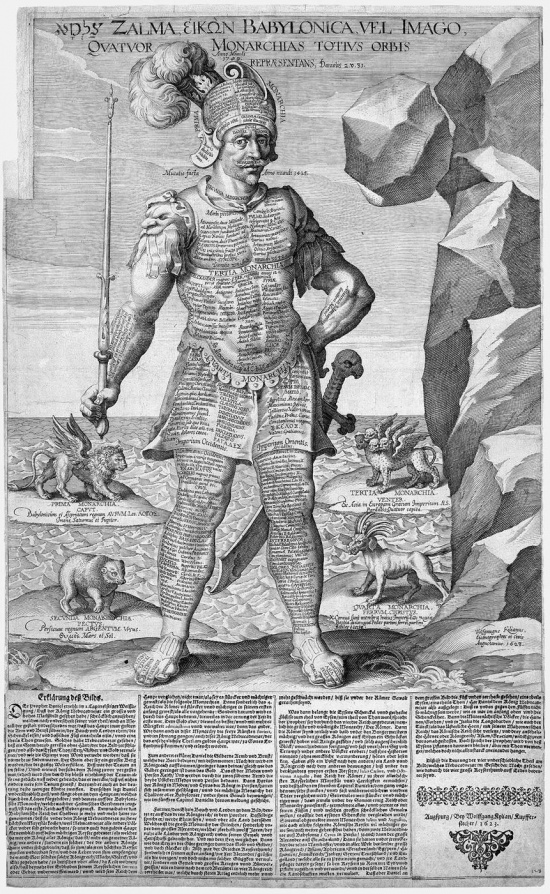Nebukadnezar-Nebuchadnezzar: Unterschied zwischen den Versionen
Aus Freimaurer-Wiki
| Zeile 1: | Zeile 1: | ||
[[Datei:Wolfgang Kilian - Nebukadnezars Traum (1623).jpg|600px|right]] | [[Datei:Wolfgang Kilian - Nebukadnezars Traum (1623).jpg|600px|right]] | ||
| + | |||
| + | [[Datei:Wolfgang Kilian - Nebukadnezars Traum (1623).jpg|550px|right]] | ||
==Nebukadnezar-Nebuchadnezzar== | ==Nebukadnezar-Nebuchadnezzar== | ||
Version vom 16. Mai 2017, 21:37 Uhr
Inhaltsverzeichnis
Nebukadnezar-Nebuchadnezzar
Der Name erscheint vielfach in freimaurerischer Literatur. Auszugsweise seien hier diverse Verweise aufgeführt:
Deutsch: Nebukadnezar
- Der große Monarch Nebukadnezar wurde Großmeister in seinem Lande und ließ viele Bauten errichten …
- AusLied der Aufseher, 1723
- auch Babylons stolze Mauern, der Sitz des Großen Nebukadnezar.
- Nebukadnezar: Turmbau zu Babel; Phaleg
Aus Der Umfang freimaurerischer Symbolik
- Viele Aspekte des Tempelbaus und seiner Einweihung um 950 v. Chr., seine endgültige Zerstörung durch Nebukadnezar 587 v. Chr. und der Bau des zweiten Tempels zwischen 537 v. Chr. und 515 v. Chr. durch Serubbabel nach seiner Rückkehr aus der Gefangenschaft in Babylon, sind in tiefgreifenden Einzelheiten als Gleichnisse in den traditionellen Graden eingearbeitet.
- Aus Tempel
- 586 v. Chr. wurde der Salomonische Tempel von dem König Nebukadnezar zerstört. Nach der Rückkehr der Juden aus dem babylonischen Exil baute ihn Zerubabel wie der auf …
Aus Tempel Salomos
- Der assyrische König Nebukadnezar II. nahm im Jahre 586 v. Chr. den Norden Israels ein.
Aus Bundeslade
- Die Bundeslade befand sich im Allerheiligsten der Stiftshütte, später des Tempels; niemand aus dem Volke durfte sie berühren oder ansehen. Bei der Zerstörung des Tempels durch Nebukadnezar ging sie wahrscheinlich durch Feuer zu Grunde, daher war das Allerheiligste des nach der Babylonischen Gefangenschaft erbauten Tempels völlig leer.
Aus Hiram Abif
- Als Hiram v. T. diese Warnung nicht befolgte, brachte Gott den König Nebukadnezar gegen ihn auf, der das Reich des Hiram zerstörte und ihn selbst einen qualvollen Martertod sterben ließ.
Englisch: Nebuchadnezzar
- Aus En: MACKEY - N
- About 630 years before Christ, the Empire and City of Babylon were conquered by Nebuchadnezzar, the King of the Chaldeans, a nomadic race, who, descending from their homes in the Caucasian Mountains, had overwhelmed the countries of Southern Asia. Nebuchadnezzar was engaged during his whole reign in wars of conquest. Among other nations which fell beneath his victorious arms was Judea, whose King, Jehoiakim, was slain by Nebuchadnezzar, and his son, Jehoichin, ascended the Jewish throne. After a reign of three years, he was deposed by Nebuchadnezzar, and his kingdom given to his uncle, Zedekiah, a monarch distinguished for his vices. Having repeatedly rebelled against the Babylonian king, Nebuchadnezzar repaired to Jerusalem, and, after a siege of eighteen months, reduced it. The city was leveled with the ground, the Temple pillaged and burned, and the inhabitants carried captive to Babylon. These events are commemorated in the first section of the English and American Royal Arch system.
- Afterwards, when this temple had been destroyed by Nebuchadnezzar, the good-will of Cyrus gave them permission to erect a second temple; he having set them at liberty for that purpose. It is from this epoch that we bear the name of Free and Accepted Masons.
- The anachronism of making Nebuchadnezzar, who lived about sixteen centuries after the event, the builder of the tower is worthy of notice. It would appear that the writer of the poem had a general acquaintance with the well‑known tradition of Babel, and that in loosely giving an account of it, he had confused the time and place of the erection and the supposed name of the builder.
- Thus, the Rev. James Anderson, the first and, naturally, one of the most noted of Masonic commentators, in the Constitutions of 1723, not only attributed a knowledge of geometry or Masonry to Adam and to virtually all of the Hebrew patriarchs, but gravely stated that, "… the Israelites, at their leaving Egypt, were a whole Kingdom of Masons, well instructed, under the conduct of their Grand Master Moses, who often marshall'd them into a regular and general Lodge while in the Wilderness, . . . the wise King Solomon was Grand Master of the Lodge at Jerusalem, and the learned King Hiram was Grand Master of the Lodge at Tyre .... the Kings, Princes and Potentates built many glorious Piles and became the Grand Masters, each in his own Territory, . . . the Grand Monarch Nebuchadnezzar . . . became the Grand Master-Mason . . . Zerubbabel the Prince and General Master-Mason of the Jews . . . . Ptolomeus Philadelphus . . . became an excellent Architect and General Master-Mason . . . the glorious Augustus became the Grand Master of the Lodge at Rome."
- Many aspects of the temple's construction and dedication about 950BC, its final destruction by Nebuchadnezzar in 587BC and the construction of the second temple by Zerubbabel between 537BC and 515BC after the return from captivity in Babylon, are incorporated in dramatic detail in parables in the traditional degrees.
You may hear as I do read,
That many years after, for great dread
That Noah's flood was all run,
The tower of Babylon was begun,
As plain work of lime and stone,
As any man should look upon;
So long and broad it was begun,
Seven miles the height shadoweth the sun.
King Nebuchadnezzar let it make
To great strength for man's sake.


